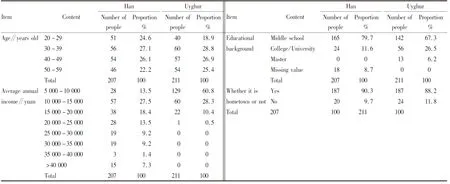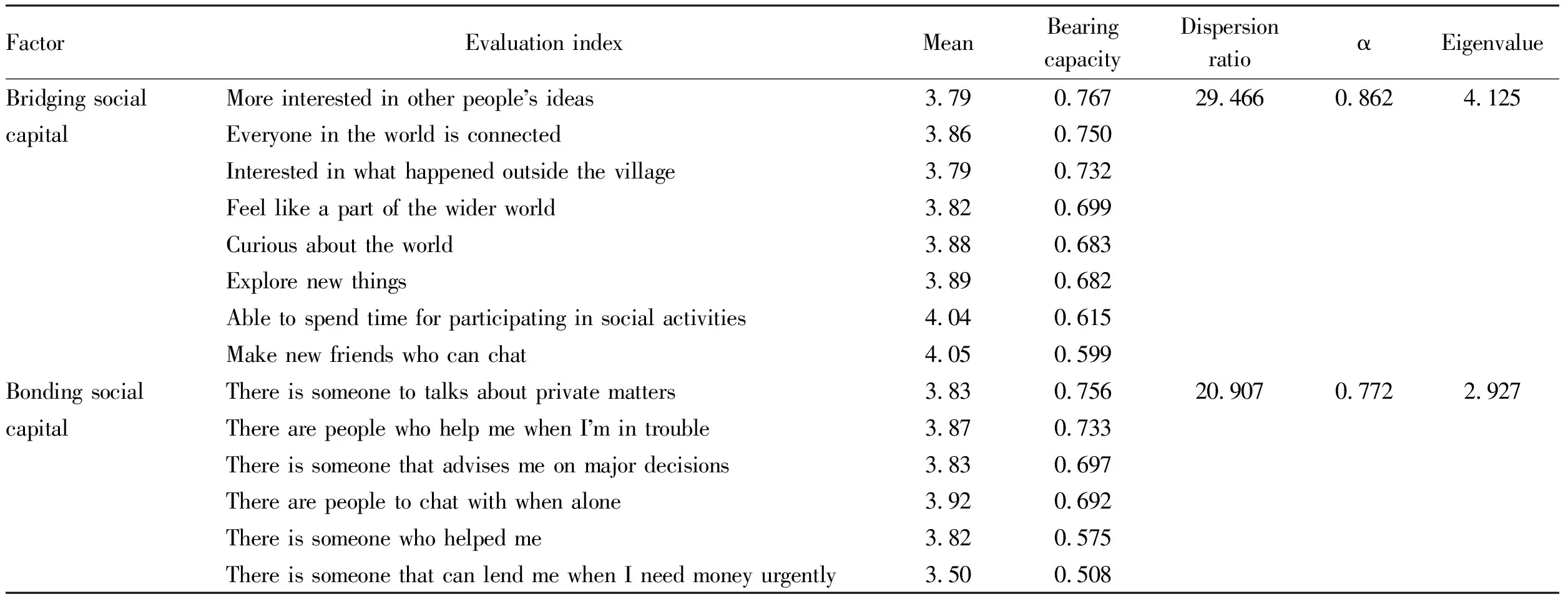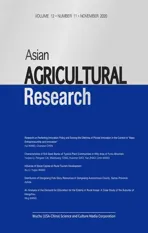Influence of Social Capital on Rural Tourism Development
2020-12-30XiuLIYuguoWANG
Xiu LI, Yuguo WANG
Taishan University, Tai’an 271000, China
Abstract In order to explore the relationship between social capital and rural tourism development effect and improve the development of rural tourism, this study takes Liutai Village in Shandong Province, 9 villages of Mangxin Township and Yuanyi Village in Xinjiang as examples and conducts empirical research. The result of exploratory factor analysis shows that social capital is divided into bonding type and bridging type, which have different characteristics and functions. The result of multiple regression analysis shows that social capital of both the two types has a significant positive impact on the development of rural tourism. In the current process of rural tourism development, the positive influence of bonding social capital is greater than that of bridging social capital. Based on the results of the empirical analysis, this paper puts forward the countermeasures and suggestions for the development of rural tourism.
Key words Rural tourism, Social capital, Rural tourism development achievement
1 Introduction
Social capital is formed in social and personal network. As a resource, it connects people[1-2]. People can exchange resources through this network[3]. Different accumulation degree of social capital indicates different economic development level, education level and dispute resolution level in a certain region[4-7]. In view of the positive effect of social capital, social capital has been actively and deeply studied in many fields.
It has been found in existing studies that social capital promotes the development of economic and non-economic achievements of regional development. On the structural level of social capital, people’s cooperation, strong ties or the closeness of social relations are all related to the economic achievements in the process of regional development[8-9]. Trust, the core element of social capital, embodies the relationship between people, and also promotes the improvement of economic achievements of regional development[10-11]. The achievements of regional development include not only economic achievements but also environmental, social, cultural and other non-economic achievements. So, in the fields of education, politics, community integration and residents’ cognition, the influence of social capital is also discussed.
The existing research makes us understand the influence of social capital. However, there is still a lack of relevant research in the field of tourism. In the small-scale regional society with the rural as the unit, residents’ social capital elements such as norms, trust, belief, network and cooperation are more prominent[2, 5, 12]. This paper makes an empirical analysis on the relationship between rural social capital and economic and-non economic achievements of rural tourism development.
2 Research design and data sources
2.1HypothesesThrough literature analysis, it can be concluded that social capital has a positive effect on both economic and non-economic achievements of regional development. Pautnam argues that social capital can be divided into two types, bridging type and bonding type, of which the characteristics and functions are different. In this paper, the impact of two different types of social capital on the development of rural tourism is analyzed, and the following hypotheses are put forward.
Hypothesis: social capital has a positive impact on the development effect of rural tourism.
Hypothesis 1: social capital has a positive impact on the economic achievements of rural tourism development effect.
Hypothesis 2: social capital has a positive impact on the non-economic achievements of rural tourism development effect.
2.2Questionnairedesign
2.2.1Social capital. The core elements of social capital are trust, participation and network. It plays a positive role in improving the coordination and cooperation within the group and the external network connection, so that the group members can help realize the interests[3]. This study divides social capital into bridging type and bonding type for empirical analysis. Bridging social capital makes it easier and faster to contact and collect external resources through weak network connection between people. Mutual benefit, extroversion, heterogeneity and inclusiveness are the main elements. Although bonding social capital has strong solidarity in group, it is exclusive to out-group personnel[9]. The main elements are emotional support, resource acquisition and exclusiveness.
2.2.2Development effect of rural tourism. Rural tourism is a powerful means of rural revitalization, and it promotes the development of rural areas. The subordinate variable of this study was the effect of rural tourism development, including the economic and non-economic achievements of rural development. According to the review of the existing literature, the economic achievements of this study were the development achievements of rural tourism industry, manifested by number of tourists and tourism income[5]. In the empirical analysis of non-economic achievement variable, the "economic achievements recognized by local residents" was used for evaluation and measurement. Non-economic achievements mainly include transportation, life, convenience, education, safety, local administrative services and community integration caused by tourism development. The non-economic achievements in this study were evaluated by "residents’ perception of non-economic achievements"[9].
2.3ResearchprocessAfter pre investigation, the questionnaire was modified and improved. The formal questionnaire survey was conducted between April 23 and May 14, 2019. It was launched in Liutai village of Feicheng City in Shandong Province, 9 villages of Mangxin Township and Yuanyi Village in Kashgar. The random sampling method was used to collect data from rural residents. A total of 468 questionnaires were put in, including 257 in the Han nationality area (207 valid, 49.5%) and 211 in Uygur nationality area (50.5%). The total number of valid questionnaires was 417.
3 Results and analysis
3.1DemographiccharacteristicsIn this study, a structured questionnaire survey was conducted among the residents in the survey area. The collected data were analyzed by descriptive analysis. The specific data are shown in Table 1.

Table 1 Demographic characteristics of the samples
3.2ExploratoryfactorsTo confirm whether the data are suitable for factor analysis, KMO and Bartlett’s identity matrix test was carried out first. According to the test results, exploratory factor analysis was carried out on the evaluation indexes. Factor analysis was carried out by using Varimax rotation analysis. All variables were extracted. The selection criteria of indices were that the eigenvalue was above 1.0, and the factor load value is above 0.5. The indices with cross factor load value less than 0.35 and Cronbach’s alpha (α) above 0.6 were judged reliable.
3.2.1Social capital factors. In the factor analysis of social capital elements, the KMO value was 0.902, and both the quantity of data and the quantity of variables are suitable for factor analysis. The result of Bartlett’s identity matrix test wasχ2= 2 548.014 (P<0.000). Therefore, factor analysis was carried out for all indices. A total of 20 indices were analyzed. Among them, the following five questions were not in line with the theoretical structure, including " people in contact with me in the village speak well of me", "some people defend me when I am unfairly treated", "there are no people in our village who do important things for me", "talking to people can make me feel connected with the larger world" and "I always like to meet new friends", and they were deleted.
Finally, 14 questions were retained. Social capital was divided into two categories by factor analysis. They were named bonding social capital and bridging social capital by referring to the existing research. The overall Cronbach’s alpha (α) value of social capital was 0.869. The α value of bonding social capital was 0.772, and that of bridging social capital was 0.862 (Table 2).

Table 2 Results of factor analysis of social capital
3.2.2Rural tourism development effect factors. In the factor analysis of rural tourism development effect, the KMO value was 0.908, suitable for factor analysis of data and variables. The result of Bartlett’s identity matrix test wasχ2= 2 092.63 (P<0.000). In this study, factor analysis was carried out on 10 indices of tourism development effect. They were divided into two categories, named "economic achievements" and "non-economic achievements" according to the existing research. The overall Cronbach’s alpha (α) value of regional social tourism development achievements was 0.89. The α value of "non-economic achievements" was 0.898, and that of "economic achievements" was 0.826 (Table 3).

Table 3 Results of factor analysis of rural tourism development effect
3.3CorrelationThe response values of bonding social capital, bridging social capital, non-economic achievements and economic achievements were 3.797 0, 3.889 9, 4.151 3 and 4.039 1, respectively. From the perspective of the relationship between bonding social capital and other variables, the correlation coefficient with bridging social capital was 0.524, showing a high degree of correlation; the correlation coefficient with non-economic achievements was 0.421; and the correlation coefficient with economic achievements was 0.322. The correlation coefficients were in the range of 0.096-0.551, indicating that the degree of correlation between the variables was not high. Therefore, the error caused by excessive correlation between independent variables should not occur (Table 4).

Table 4 Results of correlation analysis between variables
3.4HypothesisverificationMultiple regression analysis was used to verify the hypotheses. Multiple regression analysis is a statistical analysis method which regards one variable as dependent variable and one or more other variables as independent variables to establish the quantitative relationship of linear or nonlinear mathematical models among multiple variables and conducts analysis on sample data. First, the hypothesis 1,i.e., the relationship between social capital and economic achievements of rural tourism development effect was verified. Through factor analysis, the two independent variables were "bridging social capital" and "bonding social capital". Taking the economic achievements of rural tourism development as subordinate variable, a multiple regression analysis was performed on the relationship between the elements of social capital and the economic achievements of rural tourism development (Table 5).

Table 5 Influence of social capital on economic achievements of rural tourism development effect
TheFvalue of multiple regression model was 27.765 (P=0.000), indicating that the regression model was statistically significant. Thetvalue of the impact of bonding social capital on the economic achievements of rural tourism development effect was 4.769 (P<0.000), indicating that the greater the bonding social capital, the greater the positive impact on the economic achievements of rural tourism development effect. Thetvalue of the impact of bridging social capital on the economic achievements of rural tourism development effect was 2.622 (P=0.009), indicating that the greater the bridging social capital, the greater the positive effect on the economic achievements of rural tourism development effect. Through the comparison of beta values of standardization coefficient, it was found that compared with bridging social capital (0.130), bonding social capital (0.245) had a greater effect on the economic achievements of social tourism development effect. To sum up, hypothesis 1 holds.
The hypothesis 2 was verified in the same way. The analysis results about the influence of social capital on non-economic achievements of tourism development effect show that the significance of the influence of bonding social capital and bridging social capital on non-economic achievements was 0.000 (F=52.215), indicating that the regression model has statistical significance. Therefore, the hypothesis 2 is also true (Table 6).

Table 6 Influence of social capital on non-economic achievements of tourism development
In summary, the elements of social capital had a positive impact on the non-economic achievements of rural tourism development effect. Among them, bonding social capital had significant influence on the non-economic achievements of rural tourism development (P<0.000). In addition, thetvalue was 6.591, and the standardization coefficient was positive (+), indicating that the greater the social capital, the greater the positive effect on the non-economic achievements of rural tourism development effect. The bridging social capital also had a statistically significant impact on the non-economic achievements of rural tourism development effect (P<0.000). Thetvalue was 3.534, and the standardization coefficient showed a positive (+) direction, indicating that greater the bridging social capital, the greater the positive effect on the non-economic achievements of rural tourism development effect. The comparison results of the standardization coefficients of bridging social capital and bonding social capital which constitute the elements of social capital show that compared with bridging social capital (0.179), bonding social capital (0.333) had a greater influence on the non-economic achievements of rural tourism development.
4 Conclusions and suggestions
The analysis results show that both bonding social capital and bridging social capital had positive effect on the economic and non-economic achievements of rural tourism development, and bonding social capital had greater positive influence on rural tourism development than bridging social capital. It can be seen that in the process of rural tourism development in China, bonding social capital is playing a greater role. This is consistent with the research results that the social capital formed in rural China has strong characteristics of bonding social capital[12]. Therefore, in the process of rural tourism development, we should pay attention to the accumulation of social capital on the basis of positive attitude and thinking mode, establish a good sense of friendship and cooperation and intimacy, and actively guide residents to participate on the basis of mutual benefit, thus maximizing the tourism development achievements[13].
At the level of interaction, bonding social capital has high connection strength and high intension of information sharing[14]. In the process of tourism development, through sharing and exchange, it helps to improve sustainable competitiveness and create value. In addition, bonding social capital is a sense of trust and identity among members of the group. In the countryside with strong bonding social capital, residents share common rules, trust, vision and values, as well as resources, information and business opportunities[15]. The research of Coleman shows that bonding social capital strengthens organizational norms through homogeneity and close ties, and members will take actions that consider meeting group norms and achieving a shared vision, to achieve better achievements[1].
As people can share knowledge and finance within the group through bonding social capital, transactions will be conducted more effectively, the risk factors of innovation will be reduced, and the access to investment will be promoted[16]. In this regard, the bonding social capital formed in rural China can promote the development of tourism.
The positive role of bridging social capital of rural residents should be improved. The data analysis results of this study show that the impact of bridging social capital of rural residents is less than that of bonding social capital. But with the progress of rural society, the advantages of bridging social capital will be highlighted. Therefore, bridging social capital should be constructed in the process of rural tourism development, such as establishing specialized community organizations and establishing social networks with the outside world. Through social network, resources are shared and exchanged, thereby promoting the development of rural tourism.
杂志排行
Asian Agricultural Research的其它文章
- Resident Relocation of Wulingyuan World Natural Heritage Site Based on Community Participation Theory
- An Analysis of the Demand for Education for the Elderly in Rural Areas: A Case Study of the Suburbs of Hangzhou
- Comparison of Spatial Forms between Villages under Different Cultures in Jiangxi Province: Taking Meipi Village and Zhuqiao Village as Examples
- Characteristics of Soil Seed Banks of Typical Plant Communities in Hilly Area of Funiu Mountain
- Research on Dairy Consumption of Rural Residents in Yanqing District of Beijing
- Distribution of Dongxiang Folk Story Resources in Dongxiang Autonomous County, Gansu Province
